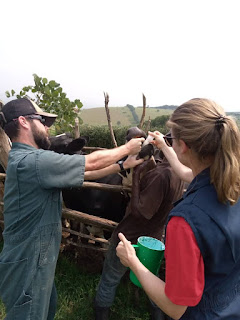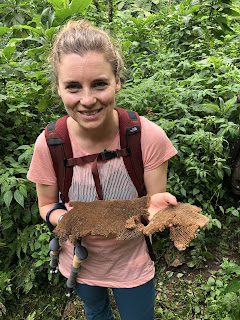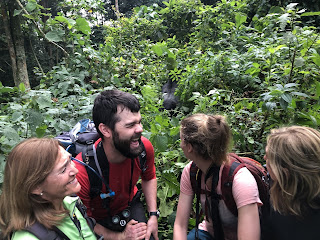Hey Guys!
After getting over some jet lag, we settled into the first week of our placement in south west Uganda, starting from Mbarara. The first week was devoted to touring three different farms that serve as practical dairy training farms (PDTFs). These farms have partnered with SNV to deliver high quality training and information sharing to the local Ugandan dairy farmers. They are a great resource for continuing education, even after the farmers have completed their training. As Vets Without Borders (VWB) volunteers, we will work closely with SNV staff, as they are the on-the-ground partner.
Each farm has developed an area of specialty. Our first tour was to AGID Dairy farm. It was a beautiful first farm to visit, set on top of the hill with great views all around. Their pastures were in great shape and the cattle looked good.
Here we met a team of four trainers and the manager. They told us all about pasture and forage management in the Ugandan system. Nutrition is their area of expertise. All the farms we have encountered so far have made extensive grazing their model. Some are using silage to supplement them through the two annual dry seasons they have, but even this is not widely practiced. In the pictures below, I talk through how they prepare and preserve silage. It is radically different from home, because they don't have the infrastructure and heavy equipment we are so fortunate to call the norm.
Here is a crew of workers putting up silage. They harvested it by hand with pangas (hand-held knives), chopped it, and loaded it into the bed of a truck.
Here is a small-scale chopper that runs on 'man power'
Then the chopped silage is dumped at the silage site, where more people drag it down the long stretch of trench that they had already dug (by hand!) and covered with plastic. They roll a 50 gallon drum over the chopped silage to flatten everything down and get as much air out as possible. Then they cover it with silage plastic before shoveling dirt over the whole thing.
Here we are standing in front of a covered silage pile with the trainers, discussing the process of silaging
They opened up a silage pile for us to look at the face.
After that, we headed to the hay shed. These are baling boxes. They lay a few strings down horizontally, stuff the box with hay, tie the strings and Voila- you have yourself a small square bale.

This is a round baler on my right. The green trailer carries the forage or grass they need to transport around the farm, and the slasher in the foreground cuts forages for someone to then pick up manually and load in the trailer. This picture was taken at the second training farm we visited, which was called M'tanoga. Their specialty was animal health, and they had the most robust vaccination program we came across in Uganda. They are vaccinating regularly for blackleg, anthrax, East Coast fever, and brucellosis. They vaccinate based on outbreaks for lumpy skin disease and foot and mouth disease. They are also treating prophylactically every three months for trypanosomiasis and spraying once weekly for ticks. That might seem like a lot, but it is barely enough to keep the ticks at bay, which carry anaplasmosis, babesiosis, heartwater and East Coast fever.

This is a spray race that the cattle walk down once a week to be sprayed for ticks. There are nozzles inside the small hut which spray their entire bodies

While we are on the subject of ticks, this is a good time to talk about eyes. Before this trip, those two things wouldn't have connected in my brain, but since arriving here in Uganda we have come to learn more about these fascinating tropical diseases. There is a syndrome of 'cattle blindness' going on in the dairy herds, and it is yet to be totally described. We have seen all sorts of bizarre eye lesions on cows. Here is a cow with cataracts, something I had never seen before. When you look online to try to find information on bovine cataracts, all you get are some random case studies of a herd of Ayrshire with congenital cataracts. However, there is something more to it here. We have seen corneal edema, ulcers, hypopyon, hyphema, cataracts, and blindness in an apparently normal eye. We have heard theories from other vets in the area- genetic, infectious (East Coast fever, Moraxella bovis). At this point, the full explanation evades us. What is tragic about the situation is that some herds have over 1/3 of the animals affected! That is a lot of blind cows. In the meantime, we are recommending that farmers do everything they can to manage the threat of ticks on their farms and promptly treat all eyes showing signs of active infection.

This poor cow has hypopyon (pus within the eye)
Here is a motorbike with milk canisters strapped to the back of it.
I like this picture because I managed to catch a motorbike with milk canisters and the milk truck heading in the opposite direction. I was shocked to learn that most of the milk produced in Uganda is milked by hand. Over 80% of the milk comes from small scale dairy farmers that ship less than 50 L of milk per day, so this is how they get their milk to the collecting facilities. Are you starting to see how labor intensive everything is here?
An early morning shot of the hazy, humid mornings we are having here in Uganda.
This chalkboard was from M'tanoga, and it helped them keep track of which cows to dry off, who was calving soon, etc. Record keeping is something that needs to be stressed here in Uganda, and we are trying to encourage farmers to use this tool to better understand what is happening on their farms.
This chalkboard kept track of who was milking, and how much. On the training farms, where performance is the best in the country, cows are peaking around 20 L per day. This is in contrast to the indigenous breed, Ankole, which milks about 2 L per day for around 200 days of lactation. Ankoles have the advantage of being immune to many of the local diseases (especially tick-borne). Many farmers are trying to capture the immunity of the indigenous breeds with the milk production of improved dairy breeds (Holstein, Jersey, etc) in a hybrid cow. This work is ongoing.

This is the milking parlor and calf barn at AGID. I was super impressed to see how clean everything was. Cleaning might be seen as something that takes work, but so does everything else here, so they are not afraid to scrub calf bottles and buckets. Water troughs were so clean a human could drink out of them. They are also trying to set the best example possible for when farmers come to the training farms, so they set a high standard.
We also walked through the cows and looked at the various species of grasses and legumes in the field. It has been a bit of a crash course for me, learning all the new species out here in the Tropics.
Luckily there are demonstration gardens at all the training farms, with handy little labels. This was the only crop I recognized, alfalfa! Here they call it Lucerne.
This dugout at the bottom of the hill at M'Tanoga holds water for the entire farm. They use solar power to pump the water up the hill into the water troughs. This was an initiative rolled out by SNV, and they have done a cost-sharing program with many farms in South West Uganda to provide accessible drinking water to cattle. Heat stress is a big factor here, and if cows can walk a short distance to water in the heat of the day, it makes a big difference.
Welcome to MARS- Mobile Animal Residue System. These pens are moved every 2 days, evenly distributing the waste and chewing down the grass at the same time. It also decreases pathogen transfer, as they get a fresh start every 2 days.
This is a methane biodigester. Manure is added in slurry form, and encased in this long plastic tube. As the methane is produced, it is gassed off into the hose at the top, which travels into the building on the right which is used like propane for cooking. This biodigester powers the yoghurt factory at M'Tanoga, made with milk from the farm.
Some students presenting a mock budget for their first year of farming. One of the big messages the trainers are trying to send is that farming is a business- outputs need to exceed inputs. This exercise helped the students realize the cost of everything, and that larger purchases need to be worked towards.
The third and final training farm we visited was Rubyerwa. It is owned by a woman named Philomena Nshangano, and I am pictured with her below. She is a great role model for women to see that they too could run a successful dairy. Though integral to the running of many farms, women and youth play a side role in Uganda. One of the missions of both VWB and SNV is to bring these important people to the discussion tables where their voices can be heard. There is a great article here on Philomena if you are interested:
https://snv.org/update/thriving-male-dominated-sector-meet-philomena-model-dairy-farmer
We toured around Rubyerwa, which specializes in animal reproduction, breeding and genetics. Philomena is using exclusively AI breeding, and she imports semen from around the world.
Cows are comfortable in the milking parlour
Canisters laid out to be filled with milk. Each canister holds 50 L, so a lot of farmers would have just one to fill each milking.
These are paper records of the cow's milk production at Rubyerwa. Philomena designed these notebooks, and sells them to interested farmers that want to keep track of how much each cow is milking. It's DairyComp in a book!
Each calf had it's important information written on a chalk board above it's head. We were very impressed with how clean and healthy the calves were. There was excellent ventilation, and her rates of calf-hood illness were extremely low.
While at this farm, we made a plan with Philomena to hold a palpation practical, as there was interest in learning how to diagnose pregnancies with rectal palpation. We did a bit of theory in the classroom before heading out to the best teachers of all, the cows.
Jared explaining some anatomy
Here we are getting down to business. I was really impressed by how quickly the herdsmen were picking it up. I barely found the cervix in my first palpation lab.
Posing for a picture at the end of the lab. Everyone on the truck was headed out to the fields to chop and load silage, before trucking it back to the silage pit.
This is an awesome picture Jared snapped one misty morning before we drove into one of the training farms. The Ankole cow has absolutely massive horns, and they are a sign of prestige in Ugandan society. Some rich people have a herd of 20-30 of them solely for the status symbol.
Thank you for your patience, this turned into a bit of a long one!
Until Next Time!










































































